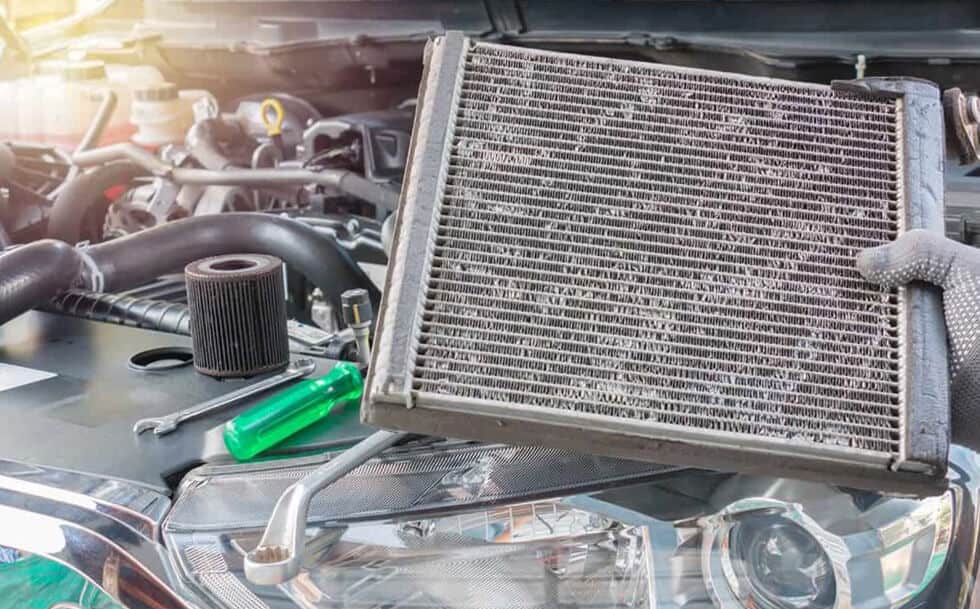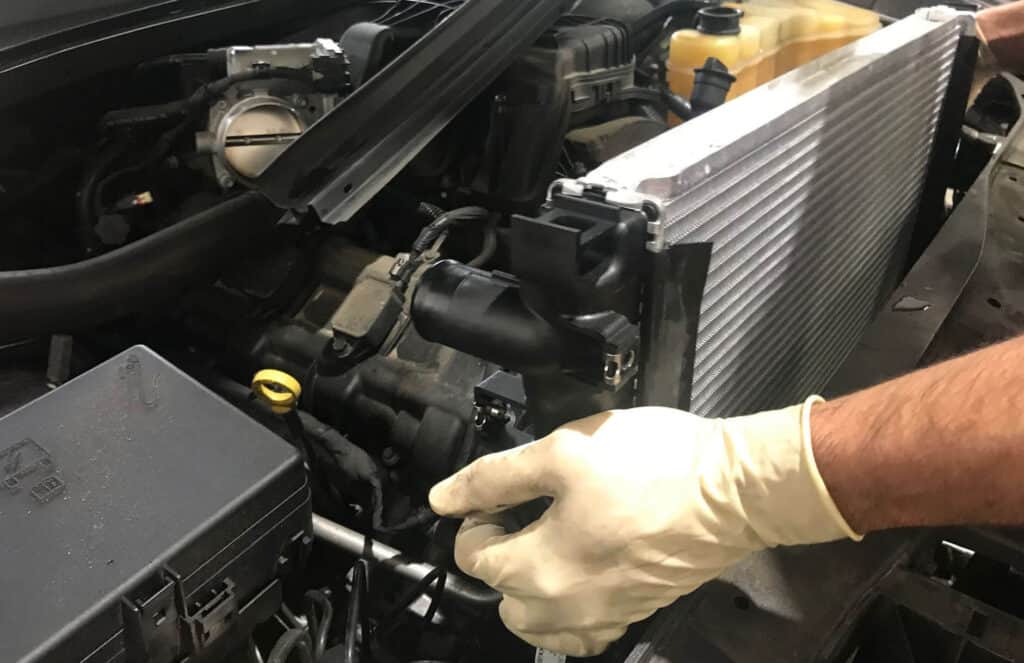Every vehicle comes with its orchestra of components, and the radiator? It’s like the conductor, ensuring the engine performs harmoniously at its optimal temperature. Without it, the engine’s heat would skyrocket, leading to a series of complications. While often overshadowed by other parts, a healthy radiator is indispensable for a car’s longevity.
Common Culprits: Top Reasons Behind Radiator Failures
Radiators, though robust, are susceptible to various issues over time. Knowing the primary culprits behind their malfunctions can provide a road map to effective maintenance and timely repairs. Here’s a deep dive into the most common reasons for radiator failures and the associated remedies.
1. Corrosion: Causes: Over time, the metal parts of the radiator can corrode, especially if the coolant isn’t replaced at recommended intervals. The corrosion can lead to holes and leaks. Repairs: Depending on the extent of the corrosion, it may require patching the holes or, in severe cases, replacing the entire radiator. Potential Cost: Patching may cost between $50-$150, while a full replacement could range from $300-$800, varying based on vehicle make and model.
2. Sediment Build-Up: Causes: Old coolant or using the wrong type can cause sediment to build up in the radiator, impeding its function. Repairs: Flushing the radiator to remove the sediment and refilling with fresh coolant. Potential Cost: A radiator flush typically costs between $70-$130.
3. Thermostat Issues: Causes: The thermostat regulates the flow of coolant. If it’s faulty, it can cause the engine to overheat as the coolant won’t flow as needed. Repairs: Replacing the faulty thermostat. Potential Cost: The replacement, including parts and labor, usually ranges from $150-$300.
4. External Damages: Causes: Accidents, debris on the road, or even minor bumps can damage the radiator’s external fins or cause punctures. Repairs: Depending on the extent, it might involve repairing the fins or replacing damaged sections. Potential Cost: Minor repairs could be as low as $50, but significant damages might push costs to $500 or more.
5. Faulty Radiator Caps: Causes: The cap maintains the right pressure in the cooling system. A faulty cap might not maintain this, leading to various issues, including leaks. Repairs: Replacing the radiator cap. Potential Cost: A new cap is relatively inexpensive, ranging from $10-$50, but ignoring the problem can lead to more significant issues.
6. Water Pump Failures: Causes: The water pump circulates coolant throughout the system. A malfunctioning pump disrupts this flow, affecting the radiator’s efficiency. Repairs: Replacing the faulty water pump. Potential Cost: Water pump replacements can vary widely based on the vehicle but generally fall in the $300-$750 range, including parts and labor.
Understanding these common culprits can equip vehicle owners with the knowledge to spot issues early, helping to avoid more significant damages and higher repair costs down the road.

Unmasking the Symptoms: Recognizing a Failing Radiator
At the first hint of these symptoms, it’s advisable to consult a professional to ensure the vehicle’s longevity and performance:
• Overheating Engine: The most immediate and visible symptom. An engine that frequently overheats indicates a radiator that’s not doing its primary job.
• Coolant Leaks: Spotting bright green, pink, or yellow fluid under your vehicle is a tell-tale sign. These puddles point towards a radiator that might be leaking coolant.
• Drastic Coolant Level Drop: If you find yourself constantly topping up the coolant reservoir, there might be a leak or internal engine consumption due to radiator issues.
• Unusual Odors: A sweet, syrup-like smell from the engine can indicate burning coolant, a symptom of a potentially malfunctioning radiator.
• Steam from the Hood: Witnessing steam or smoke emanating from under the hood is a serious sign. It means the coolant is boiling, indicating a radiator that’s not cooling the engine effectively.
• Discolored or Muddy Coolant: When checking the coolant reservoir or radiator cap, the coolant should be bright and clear. A brownish or muddy appearance could indicate rust or contaminants, hinting at radiator or engine problems.
• Fluctuating Temperature Gauge: If your car’s temperature gauge is behaving erratically, spiking then dropping, it may be due to inconsistent coolant flow caused by a radiator issue.
• Visible Damage on Radiator: Physical damages like dents, bends, or holes, even if minor, can hamper the radiator’s functionality.
• Frequent Need to Refill Coolant: If you’re constantly adding coolant far more frequently than routine maintenance suggests, it’s a sign that something’s amiss.
Remember, the radiator is pivotal for the car’s health. If these signs sound familiar, your radiator might be on the brink of failure.
Engine’s Guardian: The Typical Lifespan of a Car Radiator
In the automobile world, the radiator plays a role analogous to the heart’s cooling system. It’s that silent worker, laboring away to ensure that your car’s engine runs smoothly and doesn’t overheat. Much like any organ, it’s born with an expectancy. On average, radiators are crafted to serve faithfully for a span of 8-10 years. However, this isn’t a fixed term but more of an estimate. The make and model of your car have a significant say in this. Luxury vehicles might come equipped with radiators designed to outlast others, while those from budget-friendly models might have a modest lifespan.
But that’s just one part of the equation. The conditions under which you drive your car can be game-changers. Navigating city streets is vastly different from aggressive off-roading or cruising on highways. Plus, your geographical location plays its part. Intense summers or chilling winters can exert additional stress on your radiator. While the average lifespan provides a ballpark figure, the real secret to ensuring its longevity lies in regular maintenance. A periodic check, timely coolant replacement, and occasional flushes can be the difference between a radiator that lasts and one that gives up prematurely.
An Engine’s Worst Nightmare: The Consequences of Ignoring a Bad Radiator
Ah, the bliss of a tranquil drive – the horizon stretching out, melodies from the radio, the rhythmic hum of the engine – until it’s shattered by the hissing of steam and the abrupt halt of your vehicle. This isn’t a dramatic twist in a novel but a very real outcome of overlooking the health of your radiator. When the radiator malfunctions or isn’t performing at its optimal level, the engine loses its primary cooling system. What follows is overheating, and if you think that’s bad, the cascade of repercussions can be worse.
The overheating can cause the engine’s metal parts to warp or, worse, crack. The distress doesn’t halt there. A malfunctioning radiator will often lead to reduced fuel efficiency. As the engine grapples with soaring temperatures, it guzzles more fuel, leading to more frequent refueling stops. This strain doesn’t just dent your pocket but also takes a toll on the engine’s overall lifespan, speeding up its wear and tear. And if you’re imagining the worst-case scenario, it’s bleak: your cherished vehicle breaking down, potentially in a remote or unfamiliar location. It underscores an irrefutable fact – the well-being of your radiator isn’t just essential; it’s paramount. After all, proactive care today can ward off manifold troubles tomorrow.

Tackling the Threat: When to Seriously Consider Radiator Health
Just like you wouldn’t ignore a persistent cough, immediate attention to your radiator at the first hint of trouble is essential:
• Visual Signs: Much like spotting a cold before it becomes pneumonia, it’s crucial to catch radiator issues early on. If you notice a green, yellow, or pink fluid pooling under your car, that’s a clear indicator of a coolant leak. Addressing this promptly can save both your radiator and your wallet from significant damages.
• Odorous Alerts: Your nose can sometimes be your best diagnostic tool. A sweet or somewhat metallic smell emanating from your engine suggests a coolant leak. If this scent is coupled with steam or smoke, it’s a more urgent sign of the radiator heating up more than it should.
• Temperature Gauge: One of the most straightforward indicators of radiator health is right on your dashboard. If the temperature gauge consistently veers towards the “hot” end, it’s high time to inspect the radiator.
• Heater Inconsistencies: Feeling the cold inside your car on a frosty day despite having the heater on? A malfunctioning radiator might be preventing the coolant from heating up adequately, affecting the heater’s efficiency.
• Overheating: If your vehicle tends to overheat, especially during short drives or in cooler weather, the radiator is a likely suspect. Overheating can result from blockages, leaks, or a malfunctioning thermostat – all pointing towards radiator health.
• Routine Check-ups: Just as we need periodic health checks, radiators benefit from routine inspections. Incorporate a radiator examination into your vehicle’s regular maintenance schedule, ideally every 6 months or during every oil change.
• Post-Drive Checks: After a long drive, especially during the summer months, it’s a good practice to give your radiator a once-over. Extended journeys can exert additional strain on the radiator, making post-drive checks invaluable in spotting issues early.
To Run or Not to Run: Driving with a Damaged Radiator
• The Scenario: Imagine a scenario where your car’s temperature gauge is consistently in the red, and you’ve detected coolant leaks or perceived unusual odors. You might wonder if it’s alright to keep driving your vehicle. The analogy that best fits here is attempting to jog with a sprained ankle. While you might manage a few steps, every step taken risks worsening the injury and prolonging the recovery.
• The Repercussions: Driving with a faulty radiator isn’t just an isolated problem. It’s essentially pushing your engine into an overdrive mode without its primary cooling system. This situation can quickly escalate from a radiator issue to significant engine problems. Overheating can lead to engine parts warping or even cracking, which is not only dangerous but could also culminate in exorbitant repair costs. It’s not merely a matter of discomfort; it’s a serious risk to your vehicle’s health and your safety.
Out with the Old: Deciding on a Radiator Replacement
Sometimes, repair might suffice. But in certain situations, replacement is the way to go. Recognizing when it’s time for a new radiator ensures your car remains in tip-top shape:
• Persistent and Severe Corrosion: Over time, metal components can corrode, leading to reduced efficiency. If the radiator’s core or fins are heavily rusted, it’s often a sign that replacement is imminent.
• Multiple Failed Repair Attempts: If you’ve had the radiator patched up several times and the problems persist or reoccurring shortly after, it’s a clear indication that repairs might just be a temporary fix.
• Aging Vehicle and Radiator: The average lifespan of a car radiator can vary, but if you’re driving a vehicle that’s older and has clocked in a substantial number of miles, it’s worth considering a replacement.
• Compromised Cooling Efficiency: A primary radiator function is cooling the engine. If, after inspections and potential repairs, the engine still overheats frequently, the radiator might not be up to the task anymore.
• Visible Physical Damage: If there are significant cracks, holes, or deformities on the radiator, especially on its core, it might be more cost-effective and safer to replace than to attempt repairs.
• Clogged Passageways: Over time, sediment and debris can accumulate in the radiator’s tubes, restricting the flow of coolant. If flushing doesn’t resolve the issue, replacement might be the best option.
• Consistent Coolant Contamination: If the coolant continually appears muddy, dark, or has floating particles, it might indicate an internal breakdown of the radiator’s components.
• Cost Efficiency: Sometimes, the cost of continuous repairs might surpass that of a new radiator. In such cases, investing in a new radiator proves to be a more economical long-term solution.
• Warranty Expiration: If the radiator’s warranty has expired, and you’re facing persistent issues, it might be more feasible to opt for a new unit instead of paying out of pocket for repeated repairs.
Taking these signs into account will aid car owners in making informed decisions, ensuring their vehicles operate efficiently and safely.

Financial Forecast: Understanding Radiator Repair and Replacement Costs
No one likes surprise expenses. Knowing potential radiator repair or replacement costs ahead of time can be a financial lifesaver.
• Budgeting Ahead: Unexpected car troubles can dent our finances, especially when we’re unprepared. While most car owners might not have a precise figure for radiator repairs or replacements at the tip of their tongues, having a ballpark estimate can be incredibly beneficial. Minor radiator issues, like a simple leak or a faulty thermostat, can be addressed without burning a hole in your pocket. However, costs can vary based on the make and model of your car, as well as the nature of the damage.
• The Investment Perspective: When faced with a radiator replacement, one might balk at the expense. But it’s essential to view this not as a grudging expenditure but as an investment. A vehicle’s radiator is its safeguard against overheating, ensuring the engine runs efficiently. By allocating funds for a top-quality radiator, you’re not just ensuring better performance but potentially saving substantial amounts on future repairs. In essence, it’s about spending wisely now to avoid potentially higher costs later.
The Radiator Realm – A Balancing Act of Vigilance and Action
A vehicle’s smooth run is a delicate balance, with the radiator playing a pivotal role in maintaining the engine’s temperature equilibrium. Recognizing its significance and being proactive can make all the difference. And should you ever find yourself facing radiator woes, remember there are experts ready to help. If you’re in Canada, Uchanics mobile mechanic services are just a call away, ensuring your car remains the reliable companion it’s meant to be.
